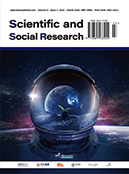Translation of Featured Words in 2019 Government Work Report from the Perspective of Skopos Theory
Abstract
Due to the development of China, more and more people have come to know about Chinese politics and culture. The Government Work Report is an authoritative document published by the Chinese government, which has been translated into English for international audiences. To ensure that the Government Work Report can be well understood by international audiences, we studied the translation of featured words in the 2019 Government Work Report from the perspective of Skopos theory. The report is analyzed from the perspective of literal translation and free translation based on the Skopos theory. Under the guidance of Skopos theory, the 2019 Government Work Report can be translated using literal translation and free translation techniques. At the same time, the translation of featured words using Skopos theory provides a more accurate expression of the original meaning of the Government Work Reports. By doing so, the communicative function of the translated text can also be achieved.
References
Nord C, 2002, Translating as a Purposeful Activity: Functional Approaches Explained. Shanghai Foreign Language Education Press, Shanghai.
Vermeer H, 1987, What Does it Mean to Translate. Indian Journal of Applied Linguistics, 1987(2): 29.
Reiss K, 2004, Translation Criticism: The Potentials and Limitations, Shanghai Foreign Language Education Press, Shanghai.
Reiss K, Vermeer H, 1984, Groundwork for a General Theory of Translation, Walter De Gruyter, Germany.
Pinkham J, 2000, The Translator’s Guide to Chinglish, Foreign Language Teaching and Research Press, Beijing.
Nord C, 2006, Text Analysis in Translation: Theory, Methodology, and Didactic Application of a Model for Translation-oriented Text Analysis, Foreign Language Teaching and Researching Press, Beijing.
Schäffner C, 2004, Political Discourse Analysis from the Point of View of Translation Studies. Journal of Language and Politics, 2004(1): 117–150.
Lafeber AP, 2012, Translation at Inter-Governmental Organizations: The Set of Skills and Knowledge Required and the Implications for Recruitment Testing. Molecular Biology & Evolution, 2012(1): 191–196.
Wu G, 2010, Transfer Redundancy in the English Translation of Government Work Reports: Analysis and Countermeasures. Chinese Translation, 31(06):64-68.
Tong F, 2007, A Brief Discussion on Literal and Free Translation in Translation. Science and Technology Information, 2007(34):163-164.
Jabir JK, 2006, Skopos Theory: Basic Principles and Deficiencies, dissertation, Basrah University.
Geng X, 2008, Literal Translation and Free Translation in Translation. Journal of North Central University, 2008(1): 30–32.
Fang Y, 2012, Literal and Free Translation: Exploration of Translation Methods, Strategies, and Meta theoretical Dimensions. Shanghai Translation, 2012 (03): 16–20.
Flynn P, 2004, Skopos Theory: An Ethnographic Enquiry. Perspectives, 2004(4): 270–285.
Vermeer HJ, 1996, A Skopos Theory of Translation, Textcontext-Verlag, Heidelberg.
Buhler K, 1990, Theory of Language: The Representational Function of Language, John Benjamins Publishing Company, Amsterdam.
Munday J, 2003, Introducing Translation Studies: Theories and Applications. Southern African Linguistics & Applied Language Studies, 2003(2): 83–85.
Douglas R, 2006, Western Translation Theory: From Herodotus to Nietzsche, Foreign Language Teaching and Research Press, Beijing.
Venuti L, 1998, Strategies of Translation, Routledge, London and New York.

